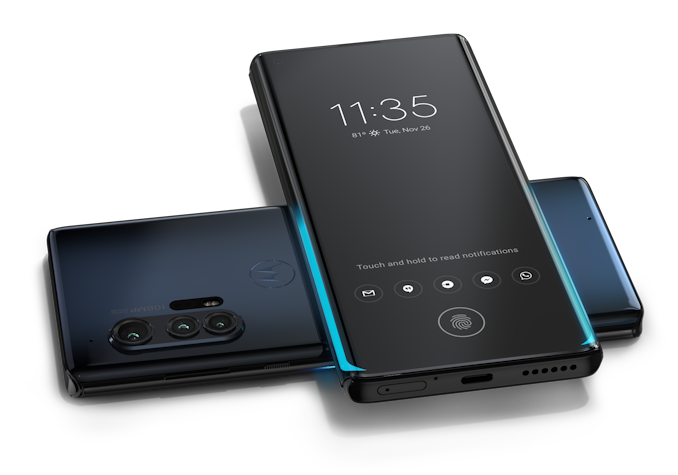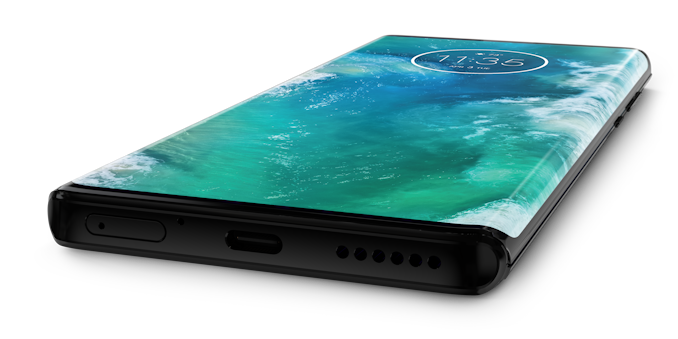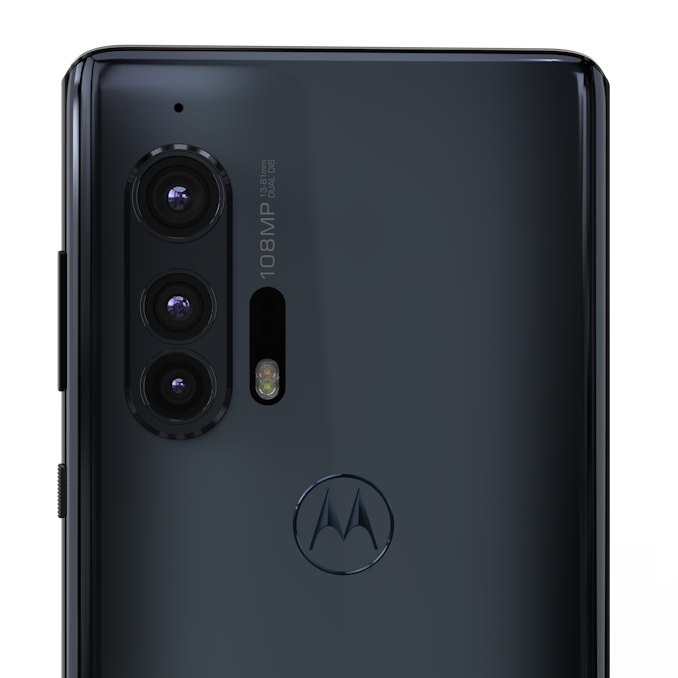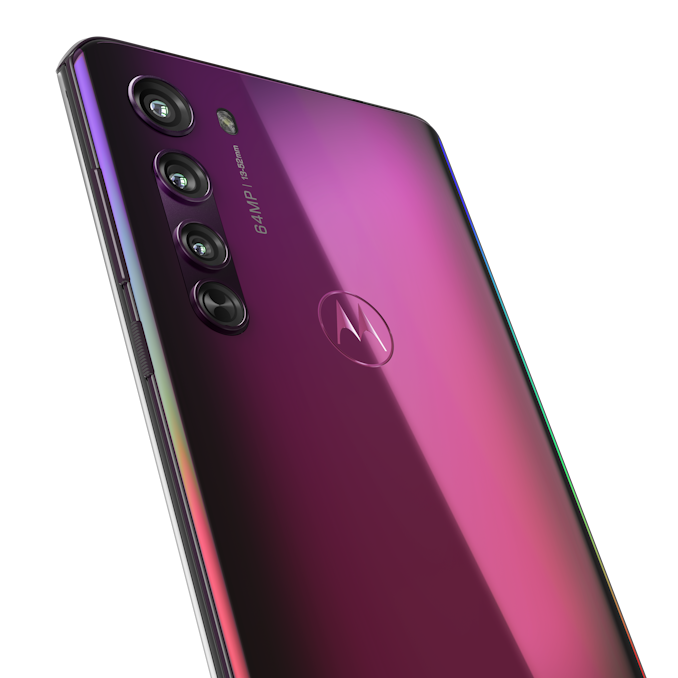Motorola Announces New edge And edge+: Re-entering the Flagship Market with a Bang
by Andrei Frumusanu on April 22, 2020 2:00 PM EST- Posted in
- Mobile
- Smartphones
- Motorola
- Motorola edge
- Motorola edge+

Today Motorola announced its newest high-end devices for 2020 – and the company delivered quite the surprise, not only returning back to the flagship market, but also delivering some quite incredibly competitive hardware in this range for the first time in years.
The new edge and edge+ from Moto are respectively premium and no-compromise flagship phones that are clearly meant to lure in customers who over the last few years might not have considered a Motorola phone in these categories.
The edge+ essentially sports all bells and whistles you can imagine in a 2020 device – a new Snapdragon 865 phone, a triple camera-setup along with a massive 108MP camera sensor, a 90Hz high refresh-rate screen, 5000mAh battery, wireless charging, IP68 rating, and even a headphone jack. The more cost-sensitive edge sports the same design and screen, but comes with a Snapdragon 765 SoC and sheds a few other features from the package.
Let’s go over the details:
|
|
||
| edge | edge+ | |
| SoC | Qualcomm Snapdragon 765 1x Cortex-A76 @ 2.3GHz 1x Cortex-A76 @ 2.2GHz 6x Cortex-A55 @ 1.8GHz Adreno 620 |
Qualcomm Snapdragon 865 1x Cortex-A77 @ 2.84GHz 3x Cortex-A77 @ 2.42GHz 4x Cortex-A55 @ 1.80GHz Adreno 640 @ 587MHz |
| Display | 6.77" AMOLED FHD+ 2340 x 1080 (19.5:9) 90Hz Refresh Rate HDR10+ |
|
| Dimensions | 161.6 x 71.1 x 9.29 mm 188 grams |
161.1 x 71.4 x 9.6 mm 203 grams |
| RAM | 6GB LPDDR4X | 12GB LPDDR5 |
| NAND Storage |
128GB UFS 2.1 | 256 GB UFS 3.0 |
| Battery | 4500mAh (17.32Wh) typ. | 5000mAh (19.25Wh) typ. |
| 15W Fast Charging | 18W Fast Charging | |
| - | 15W Wireless Charging 5W Reverse Charging |
|
| Front Camera | 25MP f/2.0 |
|
| Primary Rear Camera | 64MP 1/1.72" 0.8µm 4:1 Binning to 16MP / 1.6µm f/1.8 w/ OIS |
108MP 1/1.3" 0.8µm 4:1 Binning to 27MP / 1.6µm f/1.8 w/ OIS 6K video recording |
| Secondary Rear Camera |
16MP Ultra-Wide-Angle f/2.2 117° FoV |
|
| Tertiary Rear Camera |
8MP Telephoto 3x optical zoom f/2.4 w/OIS |
|
| Extra Camera |
- | ToF Sensor |
| 4G / 5G Modem |
Snapdragon X52 Integrated (LTE Category 24/22) DL = 1200 Mbps 4x20MHz CA, 256-QAM UL = 210 Mbps 2x20MHz CA, 256-QAM (5G NR Sub-6 4x4 100MHz + mmWave 2x2 400MHz) DL = 3700 Mbps UL = 1600 Mbps |
Snapdragon X55 (Discrete) (LTE Category 24/22) DL = 2500 Mbps - 7x20MHz CA, 1024-QAM UL = 316 Mbps 3x20MHz CA, 256-QAM (5G NR Sub-6) DL = 7000 Mbps UL = 3000 Mbps mmWave on Verizon in the US |
| SIM Size | NanoSIM + NanoSIM | NanoSIM |
| Wireless | 802.11a/b/g/n/ac BT 5.1 LE, NFC, GPS/Glonass/Galileo/BDS |
802.11a/b/g/n/ac/ax BT 5.1 LE, NFC, GPS/Glonass/Galileo/BDS |
| Connectivity | USB Type-C (2.0) | USB Type-C (3.1) |
| 3.5mm headphone jack | ||
| Special Features | On-screen fingerprint sensor, Stereo Speakers |
|
| IP54 Rating | IP68 Rating | |
| Launch OS | Android 10 | |
| Launch Prices | 699€ | 1199€ $999 (Verizon exclusive) |
Starting off with the internal hardware, both phones come with the latest SoCs in their respective categories. The higher-end edge+ sports the Snapdragon 865 for the best Android performance on the market right now, while the regular edge sports a Snapdragon 765 – a still respectable SoC but not quite as competitive as the last generations of flagships.
Motorola also equips the DRAM and storage differently based on the model. The regular edge sports 6GB of LPDDR4X and 128GB of UFS 2.1 storage, whilst the edge+ comes with 12GB of LPDDR5 and 256GB of UFS 3.0 storage.
Both phones share similar designs and in fact have the same screen specifications: A 6.77” AMOLED screen at FHD+ (2340 x 1080) resolution, and both featuring an increased 90Hz refresh rate – certainly keeping them up to date with recent trends in the smartphone market.
The “edge” moniker of the phones can be attributed to the fact that these are curved edge displays – more-so than usual as it reminds us of Huawei’s Mate 30 Pro with its almost 90° display curvatures. It doesn’t look like Motorola went for the full 90° here, but it’s still an extreme design element. For context, I wasn’t a big fan of the design on the Mate 30 Pro as I found it to be more of a cumbersome feature rather than actually benefiting the user experience. Here it seems Motorola thought of this and actually allows for blacking out of the outer-most portions of the edge, essentially hiding them.
The front screen is also characterised by a left-positioned front-facing camera hole punch. The hole is quite small here and I think the design works out well. The camera is a 25MP unit with f/2.0 optics.
The phones are quite thick – 9.29mm on the edge and 9.6mm on the edge+, exceeding the usual dimensions of other devices in the market right now. Within that thick package, Motorola was able to include a 4500mAh battery in the regular edge, and a 5000mAh battery in the edge+. Both feature fast charging up to respectively 15 and 18W, but only the edge+ also has wireless charging up to 15W as well as reverse wireless charging. The phones weigh in at respectively 188g and 203g.
Although the phones are quite chunky and the 6.77” screen diagonal might sound big – a lot of that screen real estate is actually curved, and the actual phones are only 71mm wide, making them factually smaller than many other flagship devices out there. It seems was able to maintain a very reasonable device footprint and battery capacity through the increased device thickness.
On the camera side, the edge+ comes with a 108MP main camera sensor. There’s not too much mystery as to what module we could be talking about here as there’s only one such unit being offered on the market and that’s Samsung’s HMX sensor. This is a quad-bayer unit similar to that of Xiaomi’s devices, meaning it does pixel binning down to 27MP and a resulting effective pixel pitch of 1.6µm. The optics here are f/1.8 and feature OIS.
Motorola advertises 6K video recording which is an interesting alternative to 8K that we’ve seen from Samsung on a similar sensor. In theory the edge+ would be able to support this mode whilst in the quad-bayer binning setup without too much of a crop of the sensor, probably resulting in something more useful than the S20 Ultra’s 8K video mode.
As secondary sensors, we’re seeing a 16MP ultra-wide angle module with f/2.2 optics, as well as a 3x optical telephoto module at 8MP and a f/2.4 aperture with OIS. There’s also a ToF sensor that’s only included in the edge+.
The regular edge shares the same ultra-wide and telephoto module as the edge+, but trades in the 108MP sensor in favour of a 64MP unit. This is still a large format sensor at 1/1.72” and 0.8µm pitch pixels, in a quad-bayer setup that bins regular pictures to 16MP and an effective 1.6µm pixel pitch. The aperture here is also f/1.8 and the unit comes with OIS.
Motorola had come to its senses last year by reintroducing the headphone jack in the Z4, and the two new edge phones also feature the jack – making them, alongside with LG and now Sony, one of the rare flagship devices in 2020 still sporting it.
Other differences between the two units are for example the lack of Wi-Fi 6 (802.11ax) on the regular edge, as well as a lower IP54 rating whereas the edge+ doesn’t compromise things and sports an IP68 rating. The dual-SIM support of the smaller edge is an advantage of the single-SIM setup of the edge+, but that’s likely due to the differences in target markets for both devices.
Only the edge+ in the US for now - Europe also gets the regular edge
For now, we don’t have any information about launch plans of the regular edge in the US (It's said we'll only see it later in the summer), seemingly for now this variant of the phone is only meant for other markets such as Europe, and the starting price of here is extremely reasonable at 699€.
The edge+ in Europe costs a more whopping 1199€ which really blows the budget beyond what we’re used to from Motorola phones – but of course we’re also getting an essentially no-compromise device.
In the US, the edge+ is exclusive to Verizon and comes with mmWave capabilities for $41.66 a month for 24 months, corresponding to $999.99 retail. Availability starts May 14th.
















122 Comments
View All Comments
EliteRetard - Wednesday, April 22, 2020 - link
Phone prices have gone insane, it's so bad I can't even put it into words after spending an hour trying. This thought experiment is the best I could do:Imagine the laptop market behaving this way, doubling prices in a couple years.
Now a $350 laptop costs $700 because they finally upgraded from a crap TN 720p to a mediocre IPS 1080p. $600 mid-range units are now $1200 because of incremental upgrades (like new generation CPUs and WiFi cards), and it was also really expensive to remove all the ports and force you to buy new wireless only peripherals. The previous high end $1,000 laptops just get morphed into bizarre monsters for $2500.
"Nobody wanted those old high end options, far to practical! The market demands higher prices and less utility out of the highest end. Lets remove as much battery as possible, reduce performance, make it far less durable and reliable, and justify it all with a new shiny gimmick. Instead of having the laptop hinge under the screen, lets have the screen bend!"
Aephe - Wednesday, April 22, 2020 - link
Isn't that exactly what happened with laptops though? It definitely feels like that.Aloonatic - Wednesday, April 22, 2020 - link
Haven't laptop process been creeping up, and things are going missing? Not at the same rate, but they have been.Anyway, it will be interesting how tech responds to the new global economy.
People are going to be way poorer soon thanks to mass unemployment and people who are employed being paid less on a huge scale.
Most people couldn't really afford these devices before, now they really can't and it'll be interesting to see if people wake up to this.
ClarenceNg - Wednesday, April 22, 2020 - link
All these insane price increases started with Apple dramatically increasing the price of their iPhones. The herd allowed it and continued snapping up their phones. Other phone makers see that as a sign of the market being ready for higher prices, and the rest is history...Deicidium369 - Wednesday, April 22, 2020 - link
$4500 for my first Motorola phone - needed a back brace if you planned on carrying it around most of the day. Calls were $2-3/min and required you to talk to an operator to place the call. Battery time measured in minutes.So $500-600 for a phone that is also a camera, GPS, music player, etc for $1-2/day - yeah.
sonny73n - Thursday, April 23, 2020 - link
Absurd. You’re comparing today product to one that was made 30 years ago?BedfordTim - Thursday, April 23, 2020 - link
So not far off what we have now. Still over $1000 and you still need the back brace because it is so big. Battery life is worse than it was a decade ago.Peskarik - Thursday, April 23, 2020 - link
Hidden inflation and planned obsolescense.And imagine, in inflation indices they use hedonic adjustments where they adjust the price of goods down because of the increase in "functionality"! At the same time most of the functionality is useless or foisted on you at a price and you have no choice.
dotjaz - Thursday, April 23, 2020 - link
That's not exactly true. There are new form factors involved. Phones are just getting bigger and bigger. And this year in particular, there's 5G tax of $100-200.If you compare baseline 4G S20 to S7, add in 8% inflation, the price only increased $100/€100 .
dontlistentome - Thursday, April 23, 2020 - link
8%? Inflation is close to zero everywhere. Handy fudge for your argument, though.